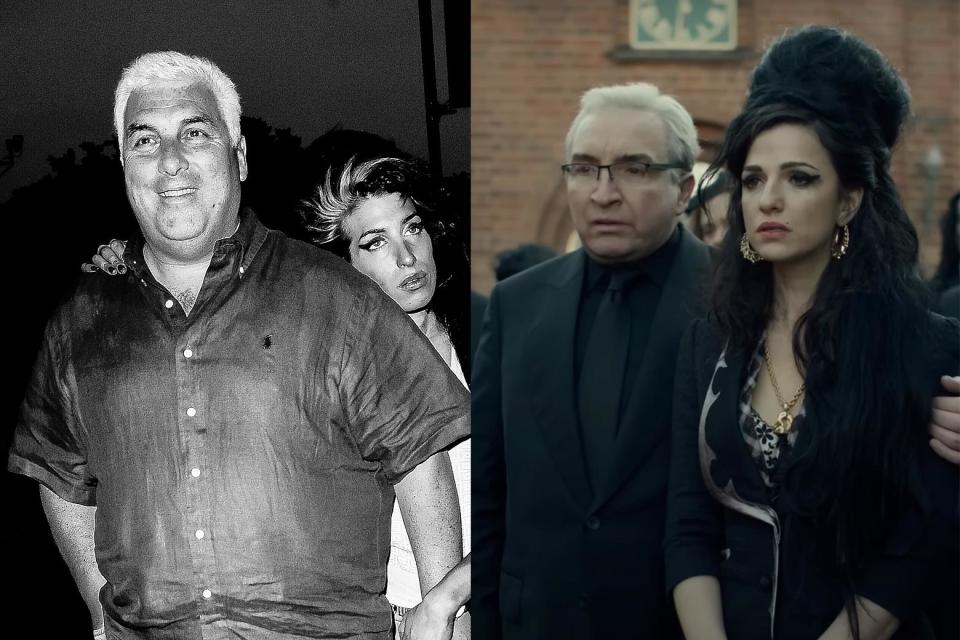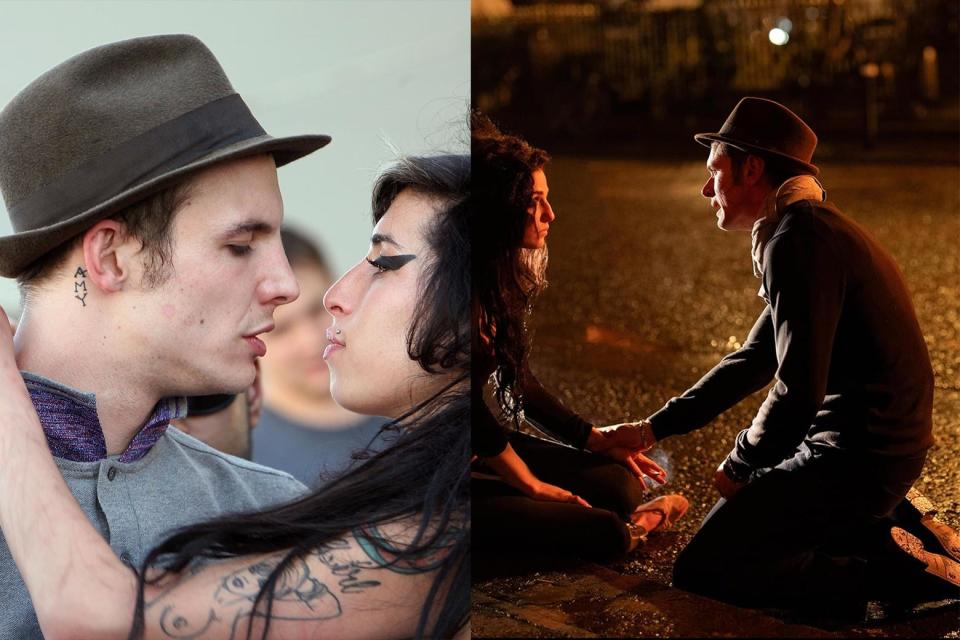What’s Fact and What’s Fiction in the Amy Winehouse Biopic
- Oops!Something went wrong.Please try again later.
Amy Winehouse often acknowledged midcentury jazz artists like Billie Holiday, Dinah Washington, and especially Sarah Vaughan as formative influences. But popular culture has depicted her more as the 21st-century version of another brilliant 20th-century vocalist, Judy Garland, whose wearing her heart not just on her sleeve but almost outside her skin won her legions of devoted fans. And whose insecurities about her appearance and weight led to her overindulging in alcohol and (prescription) drugs to the point where audiences wondered if she would be able to get through the show, and who found fame at a young age, while a parent, eager for reflected glory and the money that went with it, pushed her to keep going instead of getting her the help she needed.
Back to Black, the new biopic of Winehouse, has elements of the Garland story but leans more into another tragic diva trope, the Good Girl who falls in love with the Bad Boy and consequently falls into a downward spiral of addiction and abuse. There are also elements of Janis Joplin, another female artist who sang from the heart and was acutely conscious of her looks not meeting the industry standard, insecurities that drove her deeper into substance abuse and to an overdose at 27—the same age as Winehouse was when she died.
Rather than a linear trek through biographical details, director Sam Taylor-Johnson takes a more associative approach, centering the film around Winehouse’s on-again, off-again relationship with Blake Fielder-Civil. “I need to live my songs,” Amy says in the film, and using this as the template for telling the story results in a sort of jukebox musical charting the romance’s ups and downs accompanied by the songs they inspired on the bestselling album that gives the movie its name.
While the emotional terrain of Winehouse’s life is thoroughly examined, her creative development is less scrutinized. We see almost nothing of her in the studio, and Mark Ronson, the producer who played a major role in developing her signature sound, is conspicuous by his absence, reduced to merely a name check. Because the film focuses mainly on relationships rather than verifiable events, objective facts are thin on the ground. Nevertheless, we try to separate out the music from the noise in Back to Black.

In the film, Amy’s father, Mitch (sympathetically played by Eddie Marsan), is depicted as a bit overbearing, trying to rein in his headstrong daughter, but basically loving and supportive. But he is also shown as seriously blind to the extent of Amy’s problems—when her manager, Nick Shymansky, says the label feels she has got to go to rehab if she wants to stay signed and Amy (Marisa Abela) says no, no, no, Mitch backs her up (leading Amy to write the lyric “I ain’t got the time and if my daddy thinks I’m fine”).
Mitch, a former London black cab driver, made no secret of the fact that he thought Asif Kapadia’s acclaimed documentary Amy was unfair to him, presenting him as a sort of North London equivalent of Garland’s stage mom, out to make every dollar she could from her talented offspring and eager to turn some of the spotlight her way. “I’m just talking about balance—there is no balance. They’re happy to portray me as a money-grabbing, attention-seeking father who wasn’t there. Amy wouldn’t want that, because Amy knows that is not the truth,” he said in 2015.
The attention-seeking charge may have arisen from the fact that Mitch released his own album in 2010 when Winehouse was in bad shape and promoted it in the New York Times days before she died in 2011. “I know that I only got the chance to make the album because I was Amy’s dad. But … no one was going to let me waste money just to do some karaokes. I can sing. And I can assure you with all the people around me who love me and respect me, they wouldn’t let me do it if they thought I was going to screw it up.” Moreover, he declared, Amy had always encouraged him to make a record, recalling, “When her first album came out, and she was doing shows, she would get me onstage to do a couple of songs, and it’s always great fun. And she said, ‘You know what, Dad? You have to make an album.’ I said, ‘Are you crazy?’ And she said, ‘No, you have a great voice, this is terrific.’ ”
Mitch also strongly rebutted the charge that he was negligent in looking after his addicted daughter. In his 2012 memoir Amy My Daughter, he cites diary entries that detail how he kicked drug dealers out of her house, took her to clinics, or was just there when she needed him, all of which the biopic, which the Winehouse family has authorized, depicts.
The Amy documentary, however, actually shows Mitch saying Amy Winehouse doesn’t need to be in rehab, but Mitch claimed a crucial qualification was edited out. “They’ve edited me out saying ‘at that time,’ ” he declared to the Guardian. “Her manager came round and said: ‘She’s got to go to rehab.’ But she wasn’t drinking every day. She was like a lot of kids, going out binge-drinking. And I said: ‘She doesn’t need to go to rehab.’ In the film, I’m relating the story, and what I said was: ‘She didn’t need to go to rehab at that time.’ ”
Shymansky, her manager at Island Records, remembers it differently. “We got through a few arguments, the denial, and I got her to a place where she said, ‘OK, fine, let’s do this, I can’t lie to you, there are issues,’ ” he recalled. “So I got her to go and see the guy about rehab. At the time I didn’t really know her father, but she made it clear to me she’d do it if he backed her. So I got on the phone and lined it all up, he assured me she needed help and that he’d back me. I drove her all the way to Bluewater where he lived, and he completely backtracked. It was like she manipulated him. She sat on his lap, gave him this look like, ‘I don’t really need to go, do I?’ and he was like, ‘Of course you don’t need to go.’ ”

Amy is starting to become a sensation on the local Camden (London’s capital of grunge) music scene when she meets the cocksure, laddish Blake Fielder-Civil in a Camden pub. It’s a coup de foudre, and once Blake’s existing girlfriend is out of the way, the two fall madly in love and are soon careening around in a haze of drugs, drink, and mutual intoxication like a North London Sid and Nancy. When they meet, Amy is no stranger to weed and alcohol but turns down Class A drugs, while Blake is more of a coke man. After he leaves her show to score, they have a big fight and are photographed on a Camden street, both scratched and bleeding. Blake wants to walk away because Amy gets drunk and hits him. He is also battling his own insecurities, afraid Amy will dump him for someone famous, and six months after getting together, they split up. Blake goes back to his ex, leaving Amy to write through her heartbreak by creating Back to Black.
Blake’s dealer reminds his client of his debt and suggests he return to Amy, who is now quite successful. Although Amy has spiraled further into drinking following her beloved grandmother’s death, the couple get married in Miami in May 2007 over Mitch’s objections and on their honeymoon smoke crack together. Amy starts showing up for shows completely out of it and physically attacks Blake. Then the police burst in to her apartment, arresting Blake for assaulting a pub landlord. He is convicted and gets two years. When Amy comes to visit him in prison, he tells her he wants a divorce because the prison therapist has shown him that they are locked in a toxic codependency that is no good for either of them. Not only is Amy too extra, but he can’t deal with her father or her bulimia (Winehouse’s struggles with her weight are barely noted in the film, but she was reported to have dropped four dress sizes in 2006 due to people talking about it). He just wants normality.
While the film presents Fielder-Civil in a fairly sympathetic light, to Winehouse fans (and her father) he is the man who introduced her to hard drugs, the Bobby Brown to her Whitney Houston. But in the film, Amy calls a dealer and smokes crack before she meets Fielder-Civil. And when she cleans up, it’s only because he’s now clean and wants her to follow his good example.
In fact, Fielder-Civil told the TV program Good Morning Britain, “The drug thing is something that’s been attributed to me for years. The fact is that me and Amy only used drugs together maybe six months of our marriage. That was it. And before that, Amy didn’t use drugs. She smoked cannabis, [and] I did heroin maybe four or five times.” However, he also admitted elsewhere that he took “full accountability” for introducing Winehouse to heroin in an East London hotel when they came back from Miami. “I was smoking it on foil and she said, ‘Can I try some’ and I said … I might have put up a weak resistance—the fact is whatever I said she did end up having some,” he said on another British TV program.
As for whether Fielder-Civil battered his wife or vice versa, Winehouse herself suggested she was the aggressor, telling the Sun tabloid in June 2007, “I’ll beat up Blake when I’m drunk. If he says one thing I don’t like then I’ll chin him.” Then in August of that year, when photographs of Winehouse emerging from a hotel looking bloody and disheveled at 3 a.m. with Fielder-Civil close behind were published, Winehouse texted blogger Perez Hilton to insist, “I was cutting myself after he (BLAKE) found me in our room about to do drugs with a call girl and rightly said I wasn’t good enough for him. I lost it and he saved my life.”
Finally, Jack O’Connell, who plays Fielder-Civil, looks as though he goes to the gym every day and his preferred tipple is an energy drink while the actual BFC was cadaverous and pale in the best English rocker tradition, suggesting a vampiric lifestyle that doesn’t involve getting up before 5 p.m. Also, the film gives him a broad Cockney accent and player attitude like a Gen Z version of Michael Caine’s Alfie, when in fact Fielder-Civil, the son of a school headmaster, grew up in a leafy commuter town and attended private school.
After her divorce from Blake, Amy has come out of another stint in rehab and is doing well, not drinking, and living a fairly orderly life. But then a lurking paparazzo asks her how she feels about Blake’s new baby. Shortly thereafter, final titles inform us, she was found dead.
It seems unlikely Winehouse’s fatal binge was triggered by news of the newborn. She had already returned to rehab in 2011 but was still suffering relapses, having a European tour canceled after she turned up at a concert in Serbia too drunk to perform. When Fielder-Civil’s baby was born in May 2011, Winehouse had been dating a new partner, Reg Traviss, for a year. She died of alcohol poisoning after a period of sobriety, but two months after the baby was born.

